Leading Airport Security Software Development Solutions in the USA
 5 February 2024
5 February 2024? Listen to the Summary of this article in Audio
The forefront of airport security software development in the United States is marked by the emergence of cutting-edge companies that are redefining the standards for airport security software solutions. As the nation’s airports continue to evolve, the demand for sophisticated airport software development has never been more critical. Entities such as Thales Digital Factory, CLEAR, and Alitheon are employing innovative technologies, including artificial intelligence and machine vision, to lead the charge in safeguarding our skies and streamlining airport operations.
Key Takeaways
- American companies are spearheading initiatives in airport security with groundbreaking software developments.
- Incorporation of AI and biometrics plays a pivotal role in the advancement of airport security measures.
- Focus on enhancing passenger experience through faster and more efficient security protocols is a top priority.
- Technological integration in airport operations is pivotal in maintaining high safety standards.
- Continuous innovation reflects the United States’ commitment to superior airport safety and security.
Introduction to US Airport Security Software Development
At the heart of national safety and passenger convenience, software for airport security plays a pivotal role in the bustling activity of American airports. The USA has witnessed a surge in the development of airport security systems, with companies like CLEAR and Veracity Engineering setting the pace for technological advancements. By prioritizing the deployment of biometric technologies and streamlined management systems, these entities have not only enhanced security protocols but also simplified the complexities of airport operations.
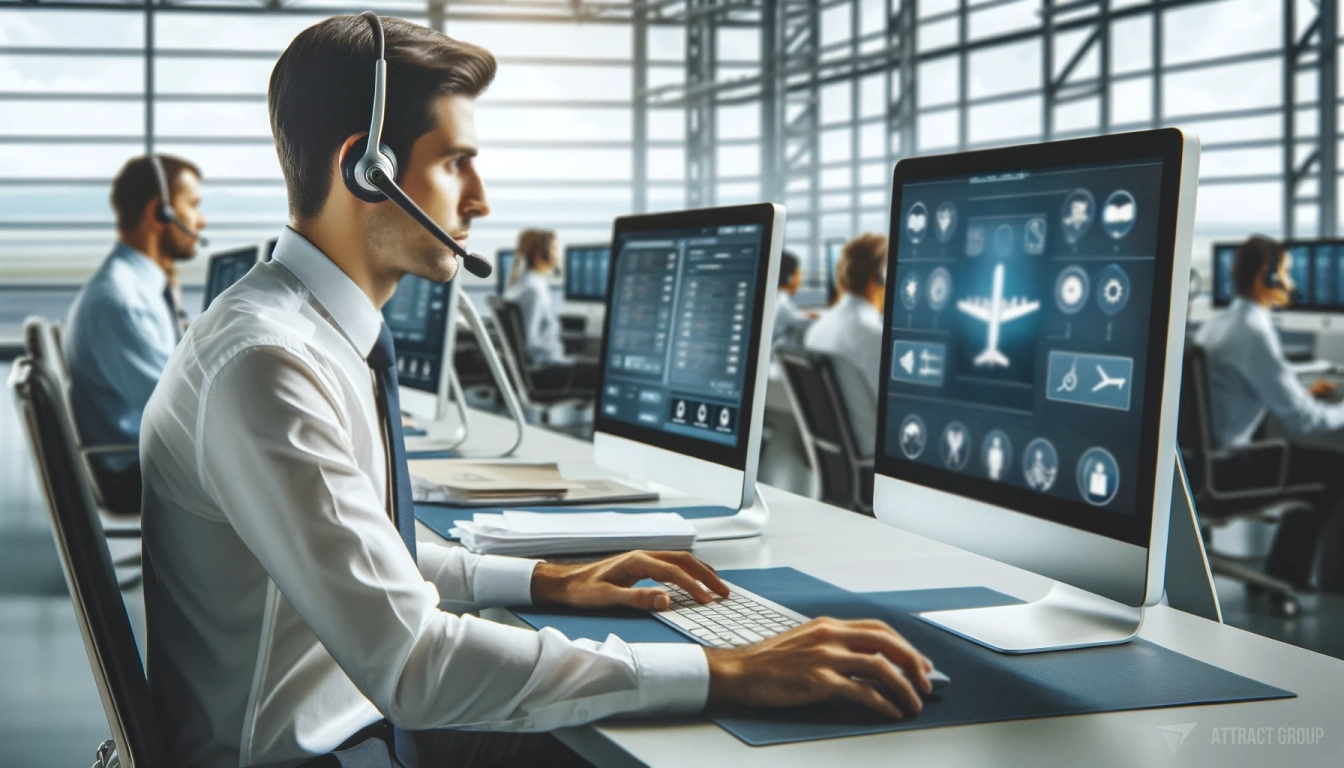
In response to the increasing need for efficiency, American innovations in airport security system development are achieving new heights. The integration of biometrics has been a game-changer in this arena, providing a fusion of speed and security that benefits both airports and passengers. This evolution is a testament to the industry’s dedication towards software solutions capable of staying one step ahead of the curve in security measures.
Let’s delve into the significant contributions made by trailblazing companies in the USA:
- CLEAR: Renowned for its expedited security clearance offerings, CLEAR has revolutionized the passenger experience by slashing wait times, harnessing the power of biometric data to ensure swift and secure airport passage.
- Veracity Engineering: Bringing over 17 years of experience, Veracity Engineering has been instrumental in applying ingenuity and practical know-how to solve complex digital issues within the aviation sector, bolstering airport security infrastructure.
Alluding to the essence of cutting-edge airport security software development, a quote from the industry exemplifies this approach:
“In the fast-evolving domain of airport security, developing responsive and robust software isn’t just about staying ahead; it’s about redefining the traveler’s journey through tech-powered vigilance and efficiency.”
The table below illustrates key players and their foundational role in the technological elevation of airport security software within the USA:
| Company | Foundation Year | Specialization | Contribution to Airport Security |
|---|---|---|---|
| CLEAR | 2010 | Biometric Security | Implementing advanced biometric screening for rapid transit through security lanes |
| Veracity Engineering | 2001 | Aviation Engineering | Providing strategic solutions for tomorrow’s problems in aviation security |
As a closing note, the momentum of these modernizations in airport security software development is impressive. An impeccable fusion of precision, swiftness, and innovation has propelled American companies to the forefront, making the USA a beacon of technological progress in the realm of aviation security.
Get a free consultation from our experts on implementing a customized software solution tailored to your airport’s unique security needs.
The Importance of Advanced Security Software in Airports
The advancement of airport security software is essential in safeguarding airports and ensuring that both passengers and employees are protected against potential threats. The implementation of such technologies is not only about enhancing passenger safety, but also about streamlining airport operations and ensuring regulatory compliance and adherence to security standards. These efforts contribute to a seamless travel experience and reinforce public trust in air travel.
Enhancing Passenger Safety with Technology
Contemporary travel demands heightened vigilance and sophistication in security measures. Companies like B-Secur and FaceFirst are at the forefront, integrating ECG biometrics and facial recognition into airport security systems. This innovative approach to security ensures that passenger identity is verified accurately, thereby enhancing overall airport safety.
The use of biometric technology marks a significant milestone in the journey of enhancing passenger safety and personalizing the travel experience.
Streamlining Airport Operations for Efficiency
To facilitate smooth operations, cutting-edge technologies from entities like the Netherlands Aerospace Center (NLR), Movexx International, and Zippsafe have been developed. These organizations focus on optimizing various facets of airport infrastructure, ranging from efficient baggage handling systems to smart storage solutions that maximize space while preserving security.
- Baggage handling innovation reduces the time passengers spend waiting for their luggage and minimizes the risk of loss or theft.
- Smart storage systems by Zippsafe utilize fabric technology to safely manage passengers’ belongings.
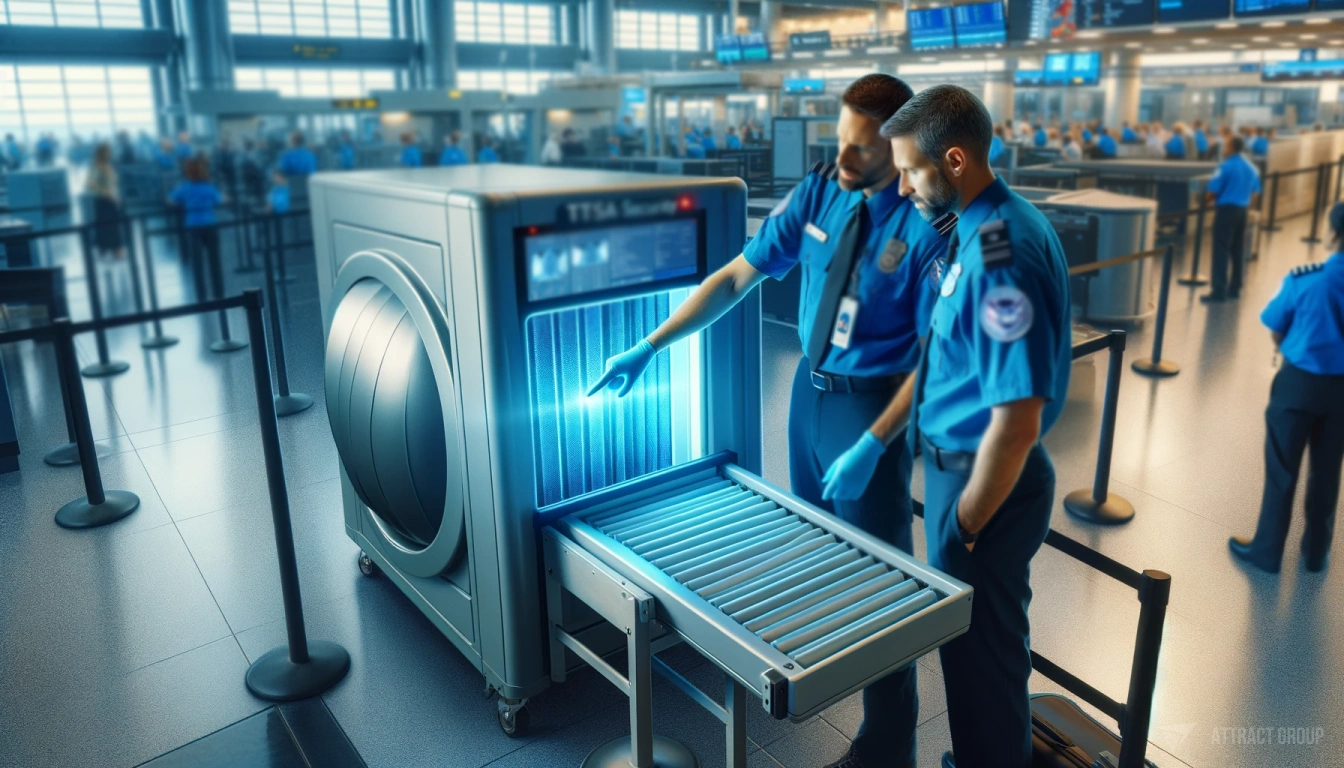
Regulatory Compliance and Security Standards
Ensuring that airport security software adheres to the stringent regulatory compliance and security standards is of paramount importance. Companies such as Meggitt, known for their specialization in extreme environment aerospace systems, and Alitheon, focusing on leveraging AI systems to enhance operational efficiency, exemplify the commitment to maintaining a secure and compliant environment.
| Company | Technology | Impact on Airport Security |
|---|---|---|
| B-Secur | ECG Biometrics | Enhances passenger identity verification and security. |
| FaceFirst | Facial Recognition | Prevents unauthorized access and strengthens airport surveillance. |
| Netherlands Aerospace Center (NLR) | Operational Efficiency Enhancements | Improves baggage handling and overall operational workflow. |
| Zippsafe | Smart Fabric Technology | Optimizes storage space while ensuring passenger item safety. |
| Meggitt | Aerospace Systems | Meets security standards and contributes to regulatory compliance. |
| Alitheon | Artificial Intelligence | Enhances security measures and operational efficiency. |
Through these multifaceted efforts, advanced airport software solutions are not only achieving new levels of security but are also redefining the efficiency of airport infrastructures worldwide.
Diving into Airport Security System Development
The quest for enhancing airport security software development in the United States has led to the emergence of leading firms like Thales Digital Factory and B-Secur. These companies are leveraging the power of advanced biometric technologies and pushing the envelope for digital transformation within the aviation sector. It’s not just about crafting software; it’s about orchestrating a symphony of integrated solutions that tighten security measures, improve passenger processing, and ensure the seamless movement of individuals from the entrance to the final point of exit at airports.
Let’s examine the innovative developments in airport security software from these bastions of technology:
- Thales Digital Factory is focusing on the future by accelerating digital transformation, enabling the development of minimal viable products (MVPs), and fostering the dissemination of digital culture within the security domain.
- B-Secur is introducing ECG biometric technology for identity verification, pushing the boundaries of how heart biometrics can secure and facilitate the airport journey.
These advancements mirror a larger trend in the ecosystem of airport security system development, where collaboration is key. The development of comprehensive security solutions relies on a network of technologies, from initial check-in processes facilitated by biometrics to advanced software systems overseeing the last point of exit.
“In airport security software development, we are not just creating systems. We are building trust, ensuring safety, and sculpting the future of air travel through innovation and collaboration.”
Our team of software engineers can build a comprehensive and integrated security system to protect your airport.
Custom Software Solutions Vs. Off-the-Shelf Airport Security Software
In the contemporary landscape of airport security, the debate between adopting custom software solutions versus off-the-shelf products is pivotal for airport administrations. Each option comes with its own set of advantages and challenges that directly impact operational efficacy and security protocols.
Custom software, uniquely tailored for airport security, is gaining traction for its ability to precisely meet the nuanced demands of modern-day airports. In contrast, off-the-shelf software, while highly accessible, may fall short in addressing the specific needs of each facility. Below, we explore the distinct benefits that tailored software for airport security presents over generic options.
Benefits of Tailored Software for Airport Security
Security presents an array of complex challenges that require solutions as dynamic and diverse as the airports themselves. Custom software solutions are specifically designed to serve this purpose, offering several notable benefits:
- Personalization: Every airport has unique security challenges; custom software is engineered to address these particular risks and requirements.
- Scalability: As airports grow and regulations change, custom software can evolve in tandem, ensuring longevity and relevance.
- Integration: Seamless assimilation with existing systems and hardware is essential. Tailored solutions are developed with compatibility in mind.
- Advanced Security: The inclusion of cutting-edge technologies like artificial intelligence, as offered by companies such as Alitheon and Aurora-AI, enables more sophisticated security measures.
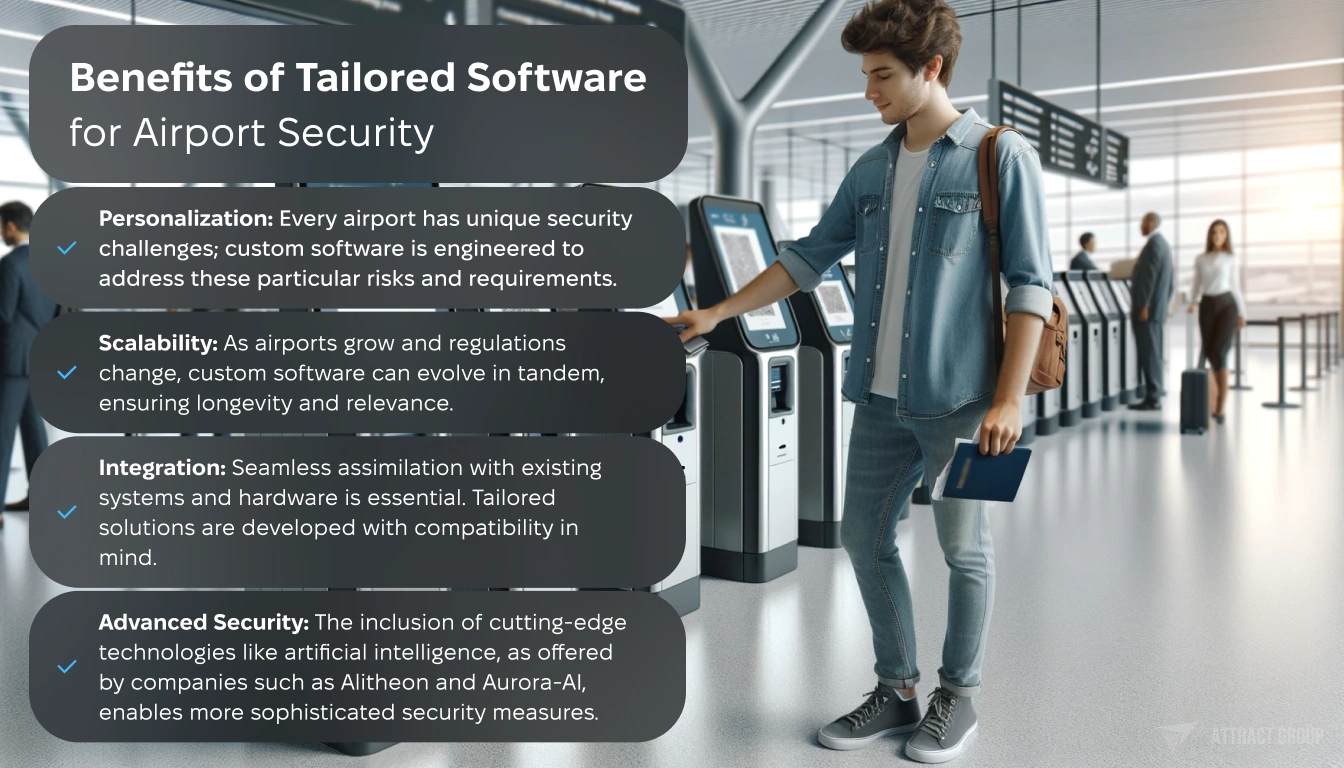
Employing a custom software approach allows airports to maintain a competitive edge in security technologies. The adaptability and personalization inherent in custom solutions ensure that specific security goals are met with precision. To illustrate this point, consider the following comparison:
| Aspect | Custom Software Solutions | Off-the-Shelf Software |
|---|---|---|
| Adaptability | Highly adaptable to airport-specific needs | Limited flexibility, often requiring workarounds |
| Security Measures | Incorporates newest technologies for bespoke security | May not include the latest security innovations |
| Cost Over Time | Cost-effective long-term due to scalability | Potentially higher costs due to frequent replacements |
| Integration | Designed to integrate smoothly with existing infrastructure | Possible compatibility issues with current systems |
While off-the-shelf solutions can offer immediate deployment and potentially lower upfront costs, they may not provide the same strategic value or breadth of customization that a custom software solution does. The care and consideration that go into developing software specifically tailored for airport security can significantly enhance an airport’s operational efficiency and security posture.
“The art of creating custom software for airport security is akin to tailoring a suit – it’s made to fit perfectly, perform flawlessly, and adapt with style to the evolving contexts of airport security needs.”
Airports considering their security software options may find that custom solutions offer a more targeted and flexible approach compared to off-the-shelf packages, akin to how Alitheon and Aurora-AI have demonstrated with their specialized AI-based security platforms.
Key Features of Effective Airport Security Software
To ensure the safety and operational efficiency of airports, the adoption of effective airport security software is crucial. This software integrates various technological advancements and complies with rigorous security regulations to create an environment that prioritizes the safety of travelers and the integrity of airport operations. Companies like Thales Digital Factory are pioneering in this realm with their impressive digital platforms centered on real-time analytics and other key features that make airport security software effective.
The key features of high-quality airport security software play a decisive role in its effectiveness, contributing to its ability to anticipate, detect, and respond to security challenges efficiently. These features include:
- Real-Time Data Analytics: Providing instant analysis and actionable intelligence to optimize airport security processes.
- Advanced Authentication Methods: Utilizing biometrics and other forms of secure access to ensure the identification of travelers and staff is accurate and reliable.
- Flexible Threat Detection: Employing AI and machine learning to adaptively recognize and neutralize potential security threats.
- Regulatory Compliance: Ensuring that the software adheres to the latest in aviation industry standards and legal requirements.
- Operational Integration: Seamlessly connecting with existing airport systems and databases for unified operations.
- User-Friendly Interface: Providing intuitive platforms that can be easily managed by security personnel without extensive training.
When it comes to effective airport security software, these features are not just add-ons; they’re the backbone of a system designed to operate with robust responsiveness and unwavering reliability.
To illustrate these points, here is a detailed breakdown of important features and their contributions to the strength of security software:
| Feature | Description | Security Enhancement |
|---|---|---|
| Real-Time Data Analytics | Enables immediate understanding and decision-making based on the current data collected within the airport’s environment. | Instant threat response and preventative action planning. |
| Biometric Authentication | Uses unique physical characteristics for identification, such as fingerprints, facial recognition, or iris scans. | Increases accuracy in identifying individuals, reducing the risk of unauthorized access. |
| Machine Learning | Allows the system to learn and adapt to new security threats over time without manual reprogramming. | Keeps security measures up to date with the latest tactics used by potential threats. |
| Compliance Assurance | Continuously monitors and adjusts to ensure local, national, and international security regulations are met. | Maintains legal integrity and avoids penalties resulting from noncompliance. |
| Systems Integration | Combines seamlessly with other airport operation systems for consistent and comprehensive security coverage. | Creates a harmonized security ecosystem that enhances overall airport security. |
| Intuitive User Interface | Incorporates a clear and easy to navigate dashboard that centralizes control and reporting. | Empowers security personnel to utilize the software effectively, thereby reducing human error. |
As airports continue to adopt and implement advanced technologies, the effectiveness of airport security software will increasingly depend on how well these key features are executed and integrated within the airport’s security infrastructure.
Conclusively, the implementation of software with such features is vital for the development of a security infrastructure that adapts to evolving threats while enhancing the efficiency of airport operations. Thales Digital Factory stands as an exemplar in this industry, demonstrating the profound impact that carefully designed airport security software systems can have in today’s high-stakes environment.
Overview of Top Airport Security Software Providers in the USA
The current climate of global security has necessitated a surge in demand for advanced security solutions at airports. Among the top airport security software providers, several have established themselves as leaders through continuous innovation, reliable performance, and stringent adherence to regulations. These providers exemplify the characteristics of premier software solutions necessary for protecting today’s airports.
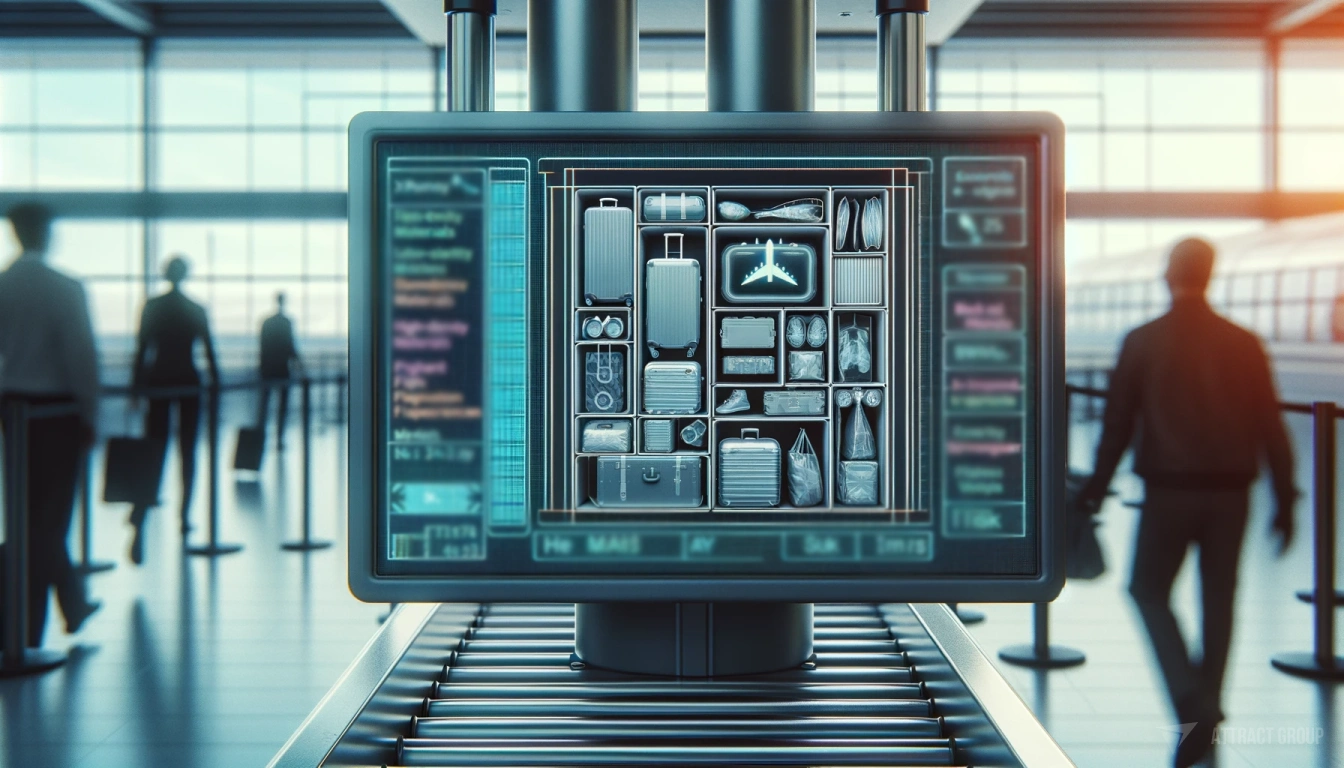
Understanding the criteria that set these providers apart is key to appreciating their role in enhancing airport security. Key determinants include the provider’s track record of innovative contributions to the industry, the reliability of their solutions across various operating conditions, and their capacity to consistently meet or exceed industry regulatory standards.
Criteria for Selection of Premier Software Solutions
Selecting premier software solutions for airport security is contingent upon certain crucial criteria:
- Innovation in developing cutting-edge technologies that push the boundaries of what is possible in airport security.
- Reliability in ensuring consistent and fail-safe operations across a spectrum of security scenarios.
- Compliance with rigorous national and international regulations, guaranteeing the highest legal and operational standards are met.
Among the top performers in this field, companies such as CLEAR and Kiana have garnered recognition through their exemplary security offerings:
- CLEAR has made a name for itself by streamlining the airport security process with its innovative use of biometrics to provide fast and predictable processing, enhancing the passenger experience without compromising security protocols.
- Kiana leverages device detection and location-based analytics to shore up security measures, ensuring a more secure and efficient airport environment.
These companies are at the vanguard of the industry, not only reacting to the changes in airport security demands but actively shaping the future of airport security technology.
“In the realm of airport security, innovation bridges the gap between user experience and operational excellence, subsequently defining the leaderboard of top software providers.”
| Provider | Innovation Highlights | Reliability Measures | Regulatory Compliance |
|---|---|---|---|
| CLEAR | Speedy biometric processing methods | Less than 5-minute processing time in member lanes | Compliance with stringent security standards |
| Kiana | Advanced device detection technology | Proven efficacy in diverse environments | International standards adherence |
The industry leaders in airport security software have set the bar high for others to follow, providing robust solutions that have a significant impact on the safety and efficiency of airport operations.
Innovative Trends in Airport Software Development
The innovative trends in airport software development stand as a testament to the dynamic nature of this sector, particularly within the domain of airport security software development. Companies like Alitheon and Aurora-AI are leading the charge by harnessing the capabilities of artificial intelligence (AI) and machine learning to conceive more intelligent and predictive security systems. Such advancements are pivotal in shaping the future of airport operations, marking a shift towards a more proactive and nuanced approach to ensuring traveler safety and airport efficiency.
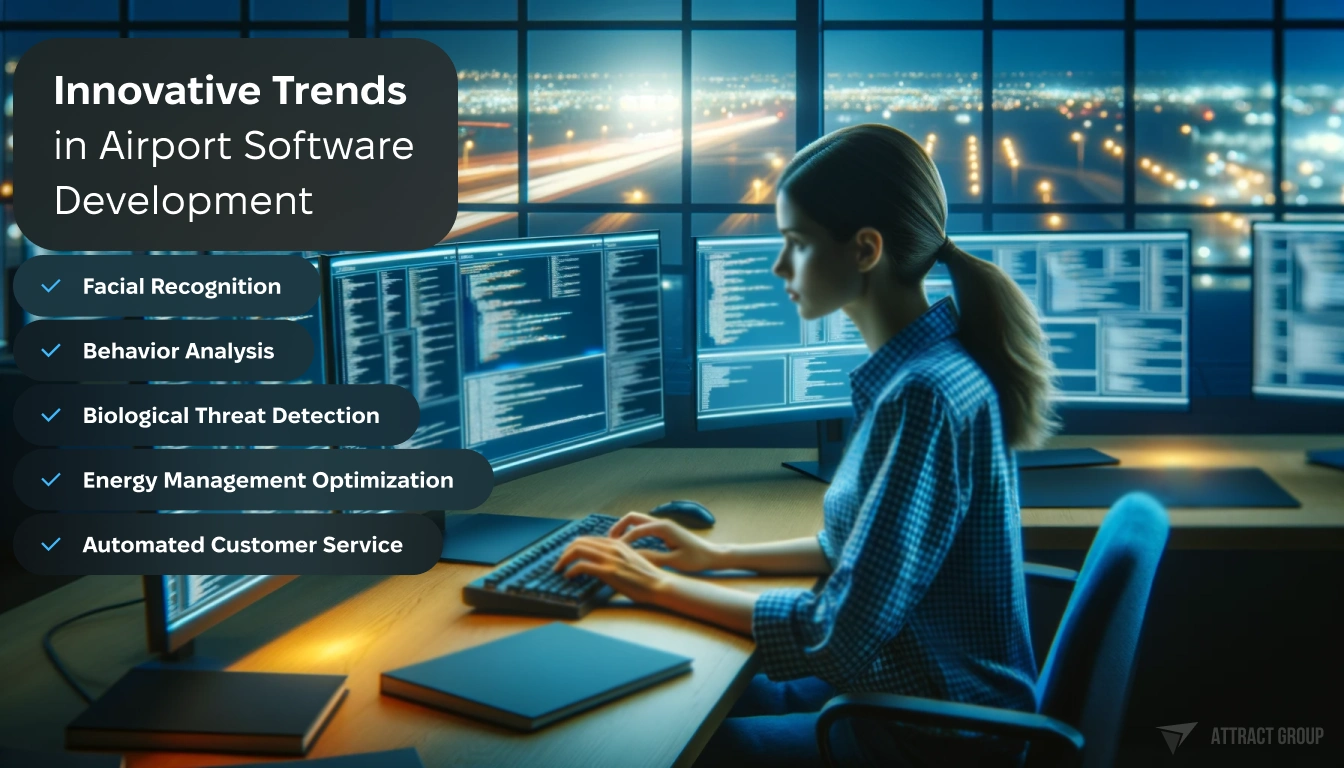
Advancements in AI have facilitated the development of an ecosystem where airport security systems are capable of advanced threat detection, data analysis, and predictive modeling, ensuring streamlined airport operations that maintain rigorous security without compromising passenger convenience. These emerging technologies offer real potential not only in elevating current security measures but also in revolutionizing how airports will function in the decades to come.
In the arena of airport software, the integration of AI and machine learning is not an embellishment—it is revolutionizing the framework of security and operations.
When contemplating the future landscape of airport software development, the role of innovative technology solutions becomes undeniably central. This shift is evidenced by the following key trends:
- Implementation of AI-powered security cameras capable of facial recognition, behavior analysis, and even detecting potential biological threats.
- Use of machine learning algorithms to optimize everything from baggage handling systems to energy management, leading to increased operational efficiency.
- Integration of natural language processing for enhanced communication systems, including chatbots and automated customer service solutions.
| Technology | Application in Airport Security | Benefit |
|---|---|---|
| Facial Recognition | Passenger Identification | Accelerates security check processes while maintaining accuracy. |
| Behavior Analysis | Monitoring Passenger Flow | Ensures optimal allocation of resources and personnel. |
| Biological Threat Detection | Detection of Contaminants | Proactively safeguards against health risks. |
| Energy Management Optimization | Facility Operations | Reduces costs and supports sustainable practices. |
| Automated Customer Service | Passenger Engagement | Improves customer experience and reduces staff workload. |
These technological strides are mirrored in the ongoing projects and services developed by companies at the forefront of the field:
- Alitheon’s AI systems are tailoring operational efficiency for commercial airlines and airports, utilizing advanced machine vision and deep learning technologies.
- Aurora-AI’s AI solutions and deep learning technology are leveraging years of expertise to offer authentication systems that cater to this generation’s security needs.
The trajectory of airport software development indicates that as machine learning and AI become more refined and accessible, we can expect a suite of software that not only boosts security but also elevates the overall airport experience for all stakeholders involved.
Leverage our expertise in AI, machine learning, and advanced analytics to take your airport’s security and operations to the next level.
Impact of AI and Machine Learning on Airport Security Software
The rapid advancements in AI and Machine Learning impact have been a game-changer for airport security software. Innovators in the field are leveraging artificial intelligence in threat detection to dramatically improve the efficacy of security protocols. Companies such as Alitheon have pioneered the use of neural networks and machine vision, culminating in systems that are not just reactive but predictive in nature.
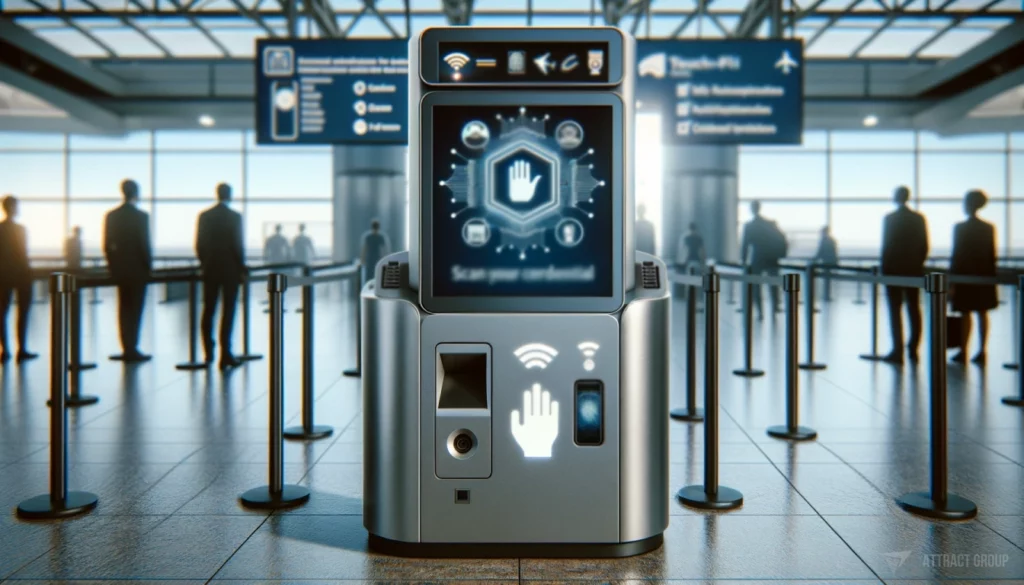
Artificial Intelligence in Threat Detection and Management
Artificial intelligence stands at the vanguard of the transformative shifts within airport security systems. AI technologies are increasingly adept at identifying potential threats through a myriad of techniques, including pattern recognition and anomaly detection. They are integral to forecasting risks and proactively managing security operations with unprecedented precision.
Advanced AI systems are redefining airport security, transforming passive surveillance into proactive threat detection and management.
These sophisticated AI systems learn and adapt over time, providing an agile response to evolving security threats. Alitheon’s approach to harnessing machine vision for the identification of unusual behaviors sets a new standard for airport security measures, going beyond dated practices to offer a resilient offense against potential risks. This strategic application of AI and machine vision exemplifies how the industry can shield crucial infrastructure from both current and emerging threats.
The tables below provide a clear contrast between traditional security systems and AI-enhanced software, highlighting the multifaceted advantages of integrating AI into the airport security framework:
| Security Feature | Traditional System | AI-Enhanced Software |
|---|---|---|
| Threat Detection | Dependent on human monitoring and straightforward algorithms. | Leverages AI for dynamic pattern recognition and preemptive threat prediction. |
| Data Processing | Manual data analysis with a higher chance of human error. | Efficient real-time analysis with machine learning for accumulating actionable insights. |
| Operational Efficiency | Constrained by system capacity and scalability. | AI-driven systems adapt and evolve, enhancing operational workflows seamlessly. |
| Response Time | Delayed responses due to the manual intervention required. | Instantaneous response by autonomous systems with minimal human oversight. |
As illustrated, AI-infused software heralds a new era for airport security, where swift, efficient, and intelligent threat detection becomes the norm, significantly strengthening the safety protocols of airlines and airport operations.
- Machine Vision: Advanced cameras paired with AI can analyze live footage, pinpoint anomalies, and flag them in real-time.
- Pattern Recognition: AI algorithms recognize deviant patterns in passenger behavior or suspicious luggage placing and alert securities proactively.
- Data Analysis: By processing vast amounts of data, AI provides a comprehensive risk assessment on an ongoing basis, ensuring an up-to-date security environment.
- Operational Integration: AI systems are increasingly integrated with other airport systems for a cohesive and comprehensive security apparatus.
In conclusion, the optimization of airport security software development through AI and machine learning is not merely incremental; it is revolutionary. The robust detection and management capabilities these technologies provide signify a fundamental shift toward a safer, more intelligent airport security infrastructure.
Case Studies: Successful Airport Security Software Implementations
In the highly specialized niche of airport security, software implementations play a crucial role in orchestrating a safe, seamless travel experience. Embracing digital evolution, staunch pioneers like Thales Digital Factory and CLEAR have demonstrated the profound capability of airport security software to bolster safety and enhance efficiency. Through a series of case studies, we can dissect these successful airport security software implementations and extract valuable insights into their transformative impact.
A close examination of these case studies not only reveals the increased speed and precision in passenger processing but also underscores a broader commitment to maintaining rigorous security standards. These real-world applications serve as beacons guiding the future trajectory of airport safety measures.
By integrating next-generation technologies, Thales Digital Factory and CLEAR manifest a future where airport security is more than a protocol — it is a passenger-centric, tech-enabled service.
The following table encapsulates the successful implementations, detailing how each company’s solution has enhanced the airport security framework:
| Company | Software Solution | Key Benefits |
|---|---|---|
| Thales Digital Factory | Thales Digital Platform | – Accelerated digital transformation – Streamlined MVP development – Pioneering startup accelerators |
| CLEAR | CLEAR Biometric Systems | – Speedy transit through security lanes – Highly predictable processing times under 5 minutes – Enhanced overall passenger experience |
Case Study: Thales Digital Factory’s Impact on Airport Security
- Implemented in several international airports, the Thales Digital Platform has been instrumental in digitizing security processes.
- Development of minimum viable products (MVPs) has led to rapid deployment and efficient scaling of security features.
- Facilitation of startup accelerators has initiated a wave of innovative security measures embracing digital culture transformation.
Case Study: CLEAR’s Biometric Revolution
- With CLEAR’s proprietary systems, airports have witnessed a drastic reduction in security queue times.
- Incorporation of biometrics has ensured that security standards remain uncompromised despite much quicker processing times.
- Enhanced passenger experience is evident from repeated positive feedback and reduced traveler stress levels.
These case studies are clear evidence of the successful advent and implementation of cutting-edge airport security software that respects the balance between operational efficiency and stringent security standards. The forward-thinking approach taken by these companies exemplifies industry best practices, driving the agenda for future airport security software development.
The aforementioned case studies serve to showcase how strategic advancements in airport security software contribute significantly to creating a secure, streamlined, and stress-free environment for travelers worldwide. They exemplify meaningful engagements between technology providers and airport authorities, aiming for a unison of convenience and protection that modern-day air travel necessitates.
The Future of Airport Security Software: Predictions and Developments
The incursion of advanced technologies in airport operations heralds a future where airport security software must continually pivot and innovate to keep pace with an evolving threat landscape. This complex, ever-shifting scenario mandates a forward-looking approach, informed by the latest trends and predictive analytics. As industry leaders like FaceFirst and B-Secur showcase, the integration of AI, biometrics, and deep learning is forming the cornerstone of tomorrow’s airport security systems.

Adapting to the Evolving Threat Landscape
The tidal wave of digital transformation has reshaped the playing field, and the future of airport security software is poised to leverage these changes to a considerable advantage. Predictions are not just informed estimations; they are built on the concrete developments and pioneering efforts of companies active in this domain today.
“As we look to the future, it becomes clear that airport security software must not just react to threats but anticipate and neutralize them before they manifest.”
Encouraging this proactive stance involves the deployment of sophisticated identification and surveillance mechanisms that go beyond traditional methods. Here’s a detailed look at how such technological proficiency is expected to evolve in response to threats:
- Biometric Authentication: Biometric systems are set to become more advanced, offering lightning-fast and impeccably accurate personal identification.
- Predictive Threat Analysis: AI will provide a nuanced understanding of risk factors, drawing from vast data pools to identify potential security breaches before they occur.
- Seamless Operational Integration: The future promises an integration of security software with operational systems, providing an all-encompassing approach to airport safety and efficiency.
The table below outlines the predicted developments in airport security software and assesses their potential impacts:
| Technological Aspect | Current Usage | Future Developments | Impact on Airport Security |
|---|---|---|---|
| Biometric Techniques | Face, fingerprint, and iris recognition | Advancements in accuracy and speed of biometric processing | Streamlined identity verification processes |
| Artificial Intelligence | Basic pattern recognition and passenger flow analytics | Sophisticated AI algorithms for advanced anomaly detection | Enhanced threat prediction and improved situational awareness |
| Machine Learning | Learning from structured datasets for static tasks | Adaptive learning from unstructured, real-time data | Dynamic adaptation to new threats and behavioral patterns |
| Operational Integration | Standalone security systems | Fully integrated solutions across the airport’s digital infrastructure | Unified security responses and operational harmony |
As cybernetic systems and machine learning algorithms become increasingly proficient, we notice an anticipatory security model emerging—one that pairs technological advancements with a human oversite to create a responsive, preemptive shield against potential threats to airport safety.
The unceasing evolution of the threat landscape, coupled with the momentum of technological progress, makes one thing clear: the future of airport security software will be defined by its adaptability, intelligence, and holistic integration into the broader airport ecosystem. With these advancements, the objective is not just to create a secure environment, but also to ensure a seamless, non-intrusive passenger experience, thereby redefining the nexus between security and convenience.
Conclusion
The landscape of airport security software in the United States is undergoing a remarkable transformation, propelled by relentless innovation and technological proliferation. American companies have taken center stage in the evolution of airport software development, integrating advanced AI and machine learning tools to construct software systems that redefine safety protocols and streamline passenger processing. This strategic fusion of technology ensures that the security software is not only efficient but also adaptable to the fast-changing spectrum of threats confronting modern airports.
Our skilled team stays ahead of the latest security technologies to build software that evolves with your airport.
Through the endeavours of trailblazing entities, the promise of next-level airport security is swiftly becoming a reality. With concerted efforts centered on enhancing operational efficacy and passenger safety, airport software development in the USA reflects an unwavering commitment to delivering superior solutions. These dynamic advancements are instrumental in paving the way toward safer, more secure airport environments that cater to both safety mandates and the need for an improved travel experience.
As we round off our exploration of the forefront of airport security software, it is evident that the ingenuity and foresight of American companies are driving progress in this critical industry. Their visionary approach is not just elevating airport safety standards but is also streamlining the complexities of airport operations, signifying a monumental leap towards an era where technology fortifies the very fabric of airport security, ensuring tranquility in the skies and beyond.
FAQ
What is airport security software development?
Airport security software development involves creating digital solutions designed to enhance the security and efficiency of airport operations. This includes everything from passenger identity verification and threat detection to regulatory compliance and operational streamlining.
Which U.S. companies are leading in airport security software solutions?
U.S. companies at the forefront of airport security software solutions include Thales Digital Factory, CLEAR, Alitheon, QinetiQ, Meggitt, B-Secur, FaceFirst, and Kiana, among others. These companies specialize in using technologies like AI, biometrics, and digital platforms to improve airport safety and operations.
How is technology enhancing passenger safety at airports?
Technology enhances passenger safety by employing advanced methods such as ECG biometrics, facial recognition, machine vision, and AI. These technologies help verify passenger identities, prevent unauthorized access, and detect potential security threats more efficiently.
What are the benefits of custom software solutions for airport security?
Custom software solutions for airport security offer tailored features that meet specific operational needs of airports, scalability for future expansion, and seamless integration with existing systems. This leads to improved security measures and operational efficiencies that are unique to each airport’s requirements.
What are the key features of effective airport security software?
Effective airport security software includes real-time data analytics, advanced authentication methods, threat detection capabilities, and the ability to meet regulatory compliance. These features are essential for maintaining high security standards while streamlining airport operations.
What criteria are used to select top airport security software providers in the USA?
The selection criteria for top airport security software providers include innovation, reliability, customer service, the ability to meet regulatory and security standards, and proven effectiveness through successful implementations and case studies.
What are some innovative trends in airport software development?
Innovative trends in airport software development include the integration of artificial intelligence (AI) and machine learning for advanced threat detection, the use of biometrics for accurate passenger identification, and the development of predictive security systems to anticipate and mitigate risks.
How do AI and machine learning impact airport security software?
AI and machine learning have a transformative impact on airport security software by enhancing threat detection and management systems, optimizing operations, and allowing for predictive analysis that can identify potential security issues before they become actual threats.
Can you provide examples of successful airport security software implementations?
Successful implementations of airport security software have been demonstrated by companies like Thales Digital Factory and CLEAR, where their solutions have reduced queue times, improved the overall passenger experience, and maintained high security standards through technology such as biometrics and AI.
What does the future hold for airport security software?
The future of airport security software is likely to see continued adaptation to evolving security threats, with increased reliance on biometrics, AI, machine learning, and more sophisticated integrations. This will lead to more adaptable and comprehensive security solutions that can address a wider array of potential risks.









